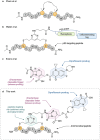β-Lactamase cleavable antimicrobial peptide-drug conjugates
- PMID: 40979881
- PMCID: PMC12447755
- DOI: 10.1039/d5sc06369h
β-Lactamase cleavable antimicrobial peptide-drug conjugates
Abstract
Antimicrobial resistance attracts a considerable amount of attention as it threatens the efficiency of current antibacterial treatments. Besides a more considerate use of current antibiotics to slow down the spread of antimicrobial resistance, there is ample need for new therapeutic avenues to treat already resistant strains. Here, we describe the use of a cleavable peptide-drug conjugate to target bacteria with diverse resistance strategies. The conjugate consists of three main components: a β-lactamase cleavable linker, a positively charged stapled antimicrobial peptide, and an antibiotic. The linker ensures selective cleavage and provides the prospect of lowering systemic toxicity of the conjugate. The positively charged peptide targets the negatively charged bacterial membrane, and stapling pre-organises it in a helical structure. Finally, the drug provides another, distinct mode of action to the peptide, which should overall reduce the development of resistance. A series of peptides was prepared and the most promising one was then developed into a stapled conjugate. The factors affecting the activity of this conjugate were investigated, proving cleavage by β-lactamase and superior potency compared to the non-cleavable control, as shown by its minimal inhibitory concentrations.
This journal is © The Royal Society of Chemistry.
Conflict of interest statement
There are no conflicts to declare.
Figures






References
-
- Hutchings M. I. Truman A. W. Wilkinson B. Curr. Opin. Microbiol. 2019;51:72–80. - PubMed
-
- O'Neill J., Tackling drug-resistant infections globally: final report and recommendations, The Review on Antimicrobial Resistance, HM Government and Wellcome Trust, 2016
-
- The PEW Charitable Trusts, A Scientific Roadmap for Antibiotic Discovery, The PEW Charitable Trusts, 2016
-
- World Health Organization, Global research agenda for antimicrobial resistance in human health, World Health Organization, 2024
LinkOut - more resources
Full Text Sources

